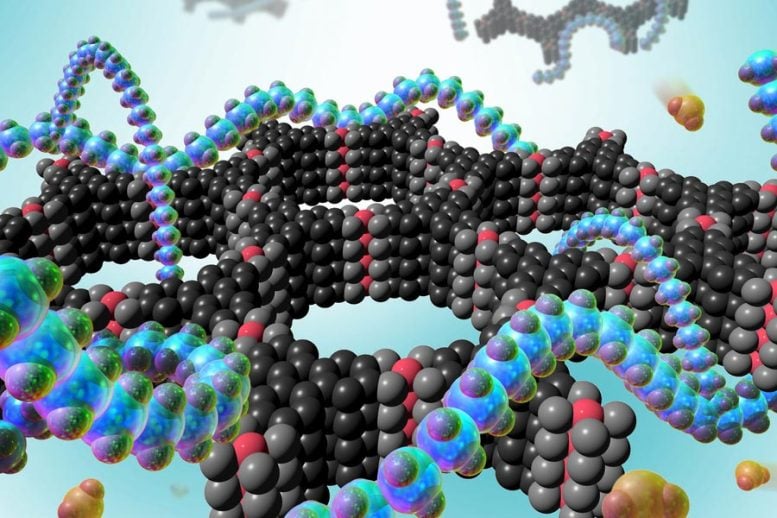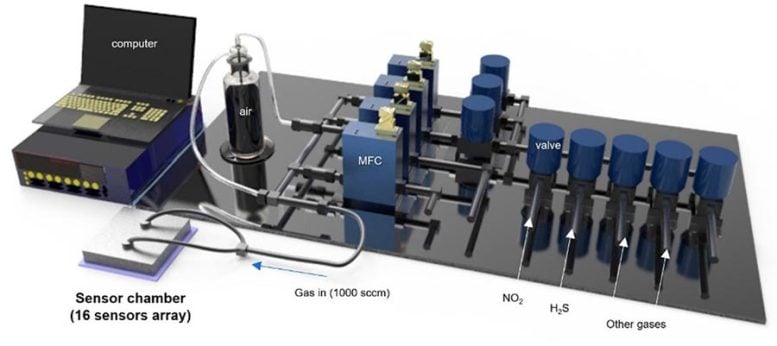
A breakthrough in gas detection technology at MIT combines high sensitivity and continuous monitoring. The material could be made as a thin coating to analyze air quality in industrial or home settings.
Most systems designed to detect toxic gases in industrial or domestic environments are limited to single or minimal uses. Researchers at MIT, however, have created a detector capable of providing continuous, low-cost monitoring of these gases.
The new system combines two existing technologies, bringing them together in a way that preserves the advantages of each while avoiding their limitations. The team used a material called a metal-organic framework, or MOF, which is highly sensitive to tiny traces of gas but whose performance quickly degrades, and combined it with a polymer material that is highly durable and easier to process, but much less sensitive.
The results are reported today in the journal Advanced Materials, in a paper by MIT professors Aristide Gumyusenge, Mircea Dinca, Heather Kulik, and Jesus del Alamo, graduate student Heejung Roh, and postdocs Dong-Ha Kim, Yeongsu Cho, and Young-Moo Jo.

Innovative Material Combination
Highly porous and with large surface areas, MOFs come in a variety of compositions. Some can be insulators, but the ones used for this work are highly electrically conductive. With their sponge-like form, they are effective at capturing molecules of various gases, and the sizes of their pores can be tailored to make them selective for particular kinds of gases. “If you are using them as a sensor, you can recognize if the gas is there if it has an effect on the resistivity of the MOF,” says Gumyusenge, the paper’s senior author and the Merton C. Flemings Career Development Assistant Professor of Materials Science and Engineering.
The drawback for these materials’ use as detectors for gases is that they readily become saturated, and then can no longer detect and quantify new inputs. “That’s not what you want. You want to be able to detect and reuse,” Gumyusenge says. “So, we decided to use a polymer composite to achieve this reversibility.”
The team used a class of conductive polymers that Gumyusenge and his co-workers had previously shown can respond to gases without permanently binding to them. “The polymer, even though it doesn’t have the high surface area that the MOFs do, will at least provide this recognize-and-release type of phenomenon,” he says.

Enhanced Sensing Capabilities
The team combined the polymers in a liquid solution along with the MOF material in powdered form, and deposited the mixture on a substrate, where they dry into a uniform, thin coating. By combining the polymer, with its quick detection capability, and the more sensitive MOFs, in a one-to-one ratio, he says, “suddenly we get a sensor that has both the high sensitivity we get from the MOF and the reversibility that is enabled by the presence of the polymer.”
The material changes its electrical resistance when molecules of the gas are temporarily trapped in the material. These changes in resistance can be continuously monitored by simply attaching an ohmmeter to track the resistance over time. Gumyusenge and his students demonstrated the composite material’s ability to detect nitrogen dioxide, a toxic gas produced by many kinds of combustion, in a small lab-scale device. After 100 cycles of detection, the material was still maintaining its baseline performance within a margin of about 5 to 10 percent, demonstrating its long-term use potential.
In addition, this material has far greater sensitivity than most presently used detectors for nitrogen dioxide, the team reports. This gas is often detected after the use of stove ovens. And, with this gas recently linked to many asthma cases in the U.S., reliable detection in low concentrations is important. The team demonstrated that this new composite could detect, reversibly, the gas at concentrations as low as 2 parts per million.
Applications and Future Directions
While their demonstration was specifically aimed at nitrogen dioxide, Gumyusenge says, “We can definitely tailor the chemistry to target other volatile molecules,” as long as they are small polar analytes, “which tend to be most of the toxic gases.”
Besides being compatible with a simple hand-held detector or a smoke-alarm type of device, one advantage of the material is that the polymer allows it to be deposited as an extremely thin uniform film, unlike regular MOFs, which are generally in an inefficient powder form. Because the films are so thin, there is little material needed and production material costs could be low; the processing methods could be typical of those used for industrial coating processes. “So, maybe the limiting factor will be scaling up the synthesis of the polymers, which we’ve been synthesizing in small amounts,” Gumyusenge says.
“The next steps will be to evaluate these in real-life settings,” he says. For example, the material could be applied as a coating on chimneys or exhaust pipes to continuously monitor gases through readings from an attached resistance monitoring device. In such settings, he says, “we need tests to check if we truly differentiate it from other potential contaminants that we might have overlooked in the lab setting. Let’s put the sensors out in real-world scenarios and see how they do.”
Reference: “Robust Chemiresistive Behavior in Conductive Polymer/MOF Composites” by Heejung Roh, Dong-Ha Kim, Yeongsu Cho, Young-Moo Jo, Jesús A. del Alamo, Heather J. Kulik, Mircea Dincă and Aristide Gumyusenge, 17 April 2024, Advanced Materials.
DOI: 10.1002/adma.202312382
The work was supported by the MIT Climate and Sustainability Consortium (MCSC), the Abdul Latif Jameel Water and Food Systems Lab (J-WAFS) at MIT, and the U.S. Department of Energy.